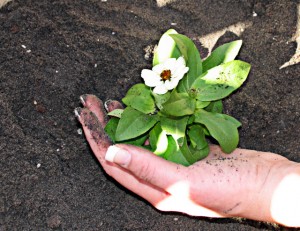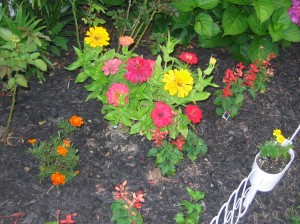April showers only bring May flowers if you plant them, but where to begin on your garden can be the hardest part. Fortunately, we can help you get started.
Fertilize
 The right type and amount of fertilizer can enhance the color, size, and amount of blooms in your flower bed. Apply it to the soil before planting. For best results, choose a fertilizer with a balanced amount of nitrogen, phosphorus, and potassium. Many gardeners use a 10-10-17 mixture. Follow package instructions for how much fertilizer to apply.
The right type and amount of fertilizer can enhance the color, size, and amount of blooms in your flower bed. Apply it to the soil before planting. For best results, choose a fertilizer with a balanced amount of nitrogen, phosphorus, and potassium. Many gardeners use a 10-10-17 mixture. Follow package instructions for how much fertilizer to apply.
Chart your space
Before you go outside and start digging, map out your plan on paper. Draw a diagram of your garden area and mark which areas get shade and sun throughout the day. This information will matter when it comes to choosing plants.
Choose plants
When selecting plants, it’s important to understand plant life cycles and plant hardiness (how well a plant handles climate extremes). Also consider what will thrive best in your natural environment. For example, if you live in a hot dry climate, look for plants that are made to survive heat and sun. If your area is wet, choose plants from a similar climate.
A plant’s life cycle is the time it takes for it to bloom, produce seed, and die. Plants are sorted into one of three categories.
- Annuals: life cycle is one growing season. They sprout in the spring, bloom, produce seed, and die before winter. If you take good care of them, most annuals will bloom all summer long.
- Biennials: life cycle is two growing seasons. During the first year they sprout and grow leaves and roots, but don’t flower. They save their blooms for the second season along with producing seed.
 Perennials: life cycle is three seasons, possibly longer in the right climate. Perennials have two categories of their own. Herbaceous means the stems die each winter and regrow from roots in the spring. Woody plant stems stick around during winter and can even create a nice backdrop for other plants. Perennials bloom during a specific set of weeks. For continuous color all season, choose a variety of early-, mid-, and late-season bloomers.
Perennials: life cycle is three seasons, possibly longer in the right climate. Perennials have two categories of their own. Herbaceous means the stems die each winter and regrow from roots in the spring. Woody plant stems stick around during winter and can even create a nice backdrop for other plants. Perennials bloom during a specific set of weeks. For continuous color all season, choose a variety of early-, mid-, and late-season bloomers.
Two more categories to keep in mind are:
- Deciduous plants: their leaves die and fall off in the winter, leaving branches bare.
- Evergreen plants: they keep their leaves year round.
Create a garden plan
This is the part that takes a little more imagination. Fortunately, you can piggyback off others’ ideas. Browse photos of different gardens and choose your favorites. Look for ways to incorporate the flowers you want. For a unique look, you might consider a themed garden like a cute cottage landscape, a tropical vista, or Asian scenery. There are even several websites that let you create a digital garden plan and play around with different styles. So get started now for a colorful summer yard.





Let Us Know What You Thought about this Post.
Leave a comment below.